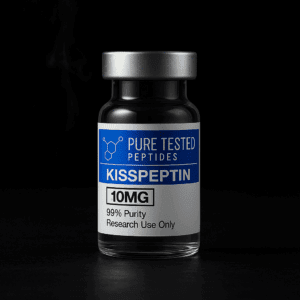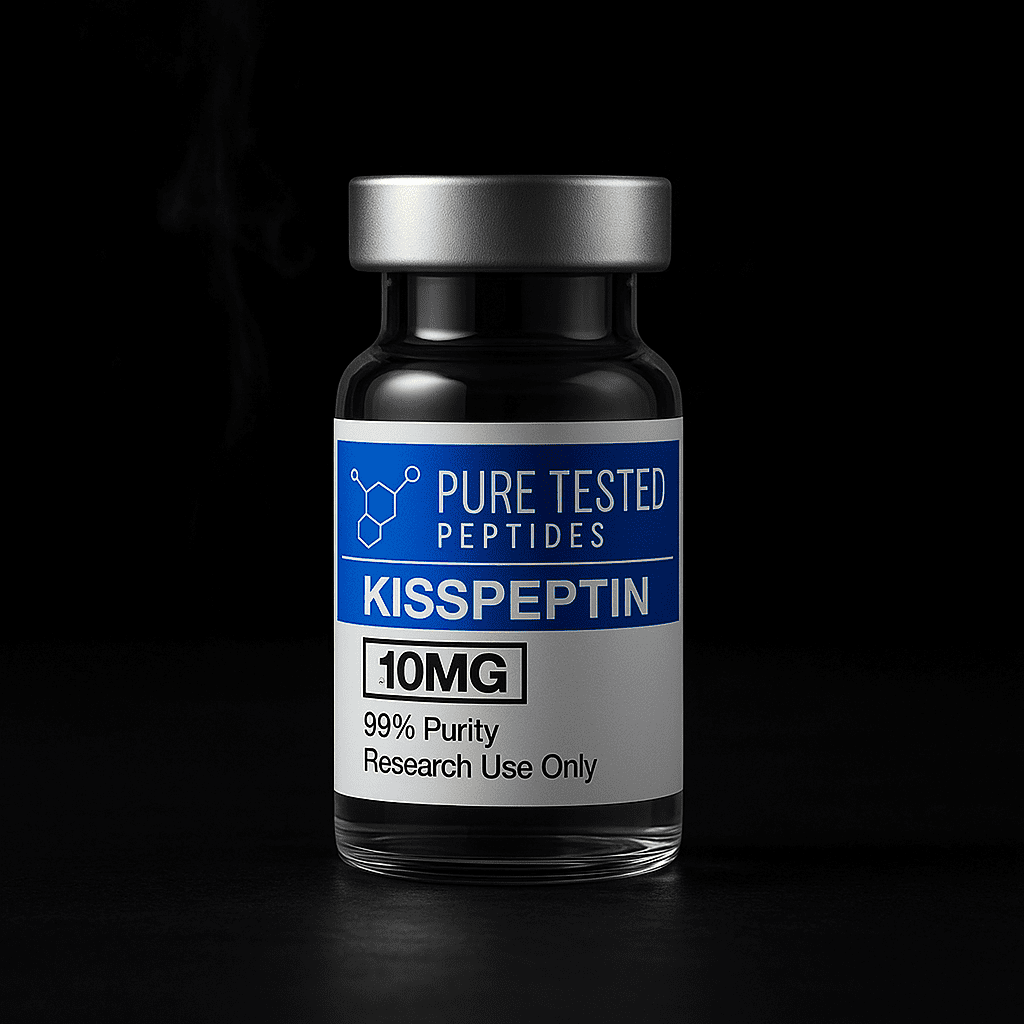Description

GPR54—also known as KISS1 receptor (KISS1R)—is a G‑protein‑coupled receptor that serves as the endogenous target for kisspeptin peptides. Genetic studies have shown that kisspeptins are the natural ligands for GPR54; loss‑of‑function mutations in GPR54 cause sexual immaturity and infertility in humans and mice. The KISS1 gene encodes a 54‑amino‑acid peptide (often called kisspeptin‑54 or metastin), but shorter C‑terminal fragments such as kisspeptin‑10, ‑13 and ‑14 retain full biological activity. In fact, the 10‑amino‑acid C‑terminal fragment is as potent as the full‑length peptide in stimulating the GPR54 receptor and in triggering luteinizing‑hormone secretion.
Kisspeptin Peptide Benefits: Reproductive Health, Mood & Sexual Function
1. Master Regulator of Reproductive Hormones & Puberty
Kisspeptin activates GnRH neurons via the GPR54 receptor, triggering luteinizing hormone (LH) and follicle-stimulating hormone (FSH) release. It’s a critical gatekeeper for puberty and fertility in humans and animals.
PubMed 20672907 [oai_citation:0‡PubMed](https://pubmed.ncbi.nlm.nih.gov/20672907/?utm_source=chatgpt.com)
PubMed 15500545 [oai_citation:1‡PubMed](https://pubmed.ncbi.nlm.nih.gov/15500545/?utm_source=chatgpt.com)
Dysregulation of this system can lead to conditions like hypogonadotropic hypogonadism or precocious puberty. [oai_citation:2‡Wikipedia](https://en.wikipedia.org/wiki/Kisspeptin?utm_source=chatgpt.com)
2. Promising Therapeutics for Fertility & Reproductive Disorders
Kisspeptin receptor agonists show therapeutic potential for treating female reproductive disorders and infertility by stimulating physiological gonadotropin release.
PubMed 33196464 [oai_citation:3‡PubMed](https://pubmed.ncbi.nlm.nih.gov/33196464/?utm_source=chatgpt.com)
Kisspeptin analogs may offer safer alternatives for inducing ovulation and reducing ovarian hyperstimulation risks in IVF.
MDPI review 2025 [oai_citation:4‡MDPI](https://www.mdpi.com/2077-0383/14/10/3284?utm_source=chatgpt.com)
3. Enhancing Sexual Desire & Brain Processing
Clinical trials show that kisspeptin administration enhances sexual brain processing and arousal in men and women with hypoactive sexual desire disorder (HSDD), with positive effects observed via MRI studies.
Imperial College study summary [oai_citation:5‡Imperial College London](https://www.imperial.ac.uk/news/242901/kisspeptin-hormone-injection-could-treat-drive/?utm_source=chatgpt.com)
Kisspeptin also modulates emotional and reproductive behaviors, influencing mood, partner preference, and sexual motivation.
Journal of Endocrinology 2018 [oai_citation:6‡joe.bioscientifica.com](https://joe.bioscientifica.com/view/journals/joe/239/1/JOE-18-0269.xml?utm_source=chatgpt.com)
4. Mood, Behavior & Metabolic Signals
Beyond fertility, kisspeptin impacts mood and behavior. For instance, kisspeptin-10 exhibits antidepressant-like effects in male rat models, mediated via adrenergic and serotonergic pathways.
PubMed 39605118 [oai_citation:7‡PubMed](https://pubmed.ncbi.nlm.nih.gov/39605118/?utm_source=chatgpt.com)
In cell studies, kisspeptin alters expression of neuropeptide Y (NPY) and BDNF, and affects dopamine and serotonin markers—suggesting roles in appetite and mood regulation.
PubMed 30477219 [oai_citation:8‡PubMed](https://pubmed.ncbi.nlm.nih.gov/30477219/?utm_source=chatgpt.com)
Summary Table
| Benefit | Kisspeptin Effects |
|---|---|
| Reproductive Hormones | Stimulates GnRH → LH/FSH; critical in puberty, fertility |
| Therapeutic Applications | Induces ovulation; potential fertility treatments |
| Sexual Desire | Improves arousal and brain responsiveness in HSDD |
| Mood & Behavior | Exhibits antidepressant-like actions; modulates appetite/mood circuits |
References
PLEASE NOTE THAT ALL PRODUCTS FEATURED HERE ARE INTENDED EXCLUSIVELY FOR RESEARCH AND DEVELOPMENT PURPOSES. THEY ARE NOT DESIGNED FOR ANY FORM OF HUMAN CONSUMPTION. THESE PRODUCTS HAVE NOT UNDERGONE EVALUATION BY THE U.S. FOOD AND DRUG ADMINISTRATION.



